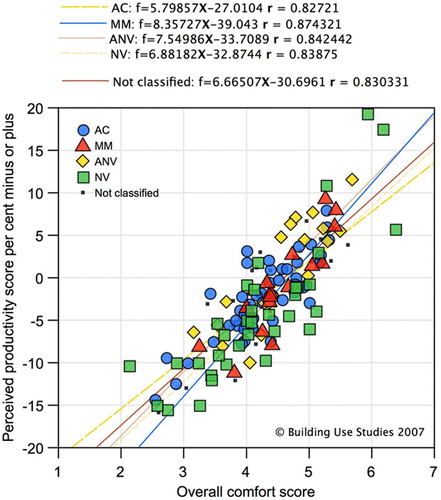Abstract
Are buildings designed for lower environmental impacts better from the occupants' point of view? Based on methodology developed in the UK by Building Use Studies and used for the Probe series of post-occupancy studies, the paper explores sources of occupant dissatisfaction, and whether or not green buildings are perceived as better by their users. Occupant surveys from 177 UK buildings are used for statistical comparisons between conventional and green buildings. Findings point to improvements in some areas, such as image and how needs are met, but green buildings are in danger of repeating past mistakes, especially if they are too difficult to manage. Users tend to tolerate deficiencies rather more than they do with more conventional buildings. There are also methodological problems. Findings based on more general, ‘summary’ questions tend give a more optimistic picture for green buildings than those which dig deeper. It is thus vital to back up statistical descriptions with detailed accounts of context so that rounded conclusions are obtained.
Les bâtiments conçus pour avoir moins d'impact sur l'environnement sont-ils meilleurs du point de vue des occupants? Cet article, basé sur une méthodologie développée au Royaume-Uni par Building Use Studies et utilisée pour la série Probe d'études de post-occupation, analyse les sources de mécontentement des occupants et cherche à savoir si les bâtiments écologiques sont mieux perçus ou non par leurs utilisateurs. Les enquêtes menées auprès des occupants de 177 bâtiments au Royaume-Uni servent à des comparaisons statistiques entre bâtiments classiques et bâtiments écologiques. Les résultats font ressortir des améliorations dans certains secteurs comme l'image et la satisfaction des besoins mais les bâtiments écologiques risquent de répéter les erreurs du passé, en particulier s'ils sont trop difficiles à gérer. Les utilisateurs ont tendance à mieux tolérer les lacunes qu'avec les bâtiments plus classiques. On note également des problèmes de méthodologie. Les résultats basés sur des questions plus générales, succinctes, ont tendance à fournir une image plus optimiste des bâtiments verts que les réponses à des questions plus approfondies. Il est donc essentiel d'accompagner les descriptions statistiques de rapports détaillés du contexte afin d'obtenir des conclusions arrondies.
Mots clés: évaluation des performances des bâtiments, aversions, mécontentement, bâtiments verts, appétitions, occupants, évaluation post-occupation, durabilité, utilisateurs
Introduction
Are users more tolerant of ‘green’ buildings? This question is examined in light of building evaluation surveys carried out over the past decade. About half the buildings surveyed had been designed with some kind of ‘green intent’. That is, their design brief requires the building to achieve lower environmental impacts. Do ‘green’ buildings have features that occupants like, and are occupants more tolerant of shortcomings?
Evidence is drawn from occupant surveys of 177 buildings in the UK carried out by Building Use Studies and licensees since 1995. Some of these have been written up as part of the Probe series of post-occupancy series. The total Building Use Studies data set worldwide has 310 buildings. A companion paper on a similar topic is also available for Australia (Leaman et al., Citation2007). The Building Use Studies methodology is described more fully at: http://www.usablebuildings.co.uk/WebGuide OSM/index.html/.
The authors' perspective is one of improvement. It has been found that it often makes more sense for designers to try to remove sources of user dissatisfaction rather than providing more things they hope users will like. The logic may sound a little strange but for building users the absence of, for example, thermal discomfort or unwanted interruptions is often more important. Building users are satisficersFootnote1 not optimizers, they adapt and cope. They trade-off good things against bad, reach compromises with their colleagues, and put up with shortcomings within reason. They often give designers and managers the benefit of the doubt if they like the design, but they can be scathing if they think that the building is, for example, too complicated, self-indulgent, ostentatious or makes them look stupid. It would be nice if everyone was happy all the time, but because individual circumstances differ so much this is usually impossible. Expedient courses of action are often the most sensible.
The first part looks at examples of user dissatisfaction. The second examines ratings from occupant surveys to explore whether users are more tolerant of ‘green’ buildings. (The term ‘green’ will be used without inverted commas from now on.) The buildings being written about are more sustainable in design intent, not necessarily in reality. It is found, for example, that carbon dioxide emissions from supposedly green buildings are commonly two or even three times as much as predicted (Bordass, Citation2001).
Users' likes and dislikes
Even in buildings with the highest ratings in occupant surveys – which make them amongst the best possible – there will be 5–10% of occupants who say they are uncomfortable or dissatisfied with something or other.Footnote2 The lowest-rated buildings will have 70–80% of occupants dissatisfied, and in some instances 100%. It is common to find 30–40% dissatisfied, so it makes sense to try and reduce dissatisfaction by understanding its roots, and developing appropriate design and management responses.
In doing this, orders of priority need to be established. Which types of dissatisfaction are the most important to individuals and organizations? One can provisionally gauge this by seeing how ratings of perceived productivity at work associate with some of the principal environmental variables for temperature in the summer, temperature in the winter, ventilation/air in the summer, ventilation/air in the winter, lighting, and noise (). The stronger the association, the more likely the effect of the given variable on perceived productivity.
Table 1 Order of importance for variables' influence on perceived productivity ratings by ventilation type: BUS UK building data set
Earlier work using this approach has found that the order of importance of variables has often been as follows:
| • | overall comfort (the variable which has the strongest association with the variable perceived productivity) | ||||
| • | temperature in summer and winter | ||||
| • | ventilation/air in summer and winter | ||||
| • | lighting | ||||
| • | noise | ||||
From , the orders of importance for both naturally ventilated (NV) and advanced naturally ventilated (ANV)Footnote3 are as follows:
| • | comfort overallFootnote4 | ||||
| • | temperature in winter | ||||
| • | ventilation/air in winter | ||||
| • | noise | ||||
| • | ventilation/air in summer | ||||
| • | temperature in summer | ||||
| • | lighting | ||||
| • | comfort overall | ||||
| • | air in winter | ||||
| • | air in summer | ||||
| • | temperature in summer | ||||
| • | temperature in winter | ||||
| • | noise | ||||
| • | lighting | ||||
| • | comfort overall | ||||
| • | ventilation/air in summer | ||||
| • | lighting | ||||
| • | ventilation/air in winter | ||||
| • | temperature in winter | ||||
| • | temperature in summer | ||||
| • | noise | ||||
| • | for NV and ANV, wintertime discomfort can be just as, or more, important than summertime discomfort | ||||
| • | temperature in summer is more important with AC buildings, the reverse of what might normally be assumed; of course, AC buildings can be regarded as too cold in summer, and there tends to be less occupant control | ||||
| • | noise is having an increasing effect on perceived productivity, especially in NV and ANV types | ||||
points to why some of these differences between ventilation types might arise. Forgiveness scoresFootnote5 are higher for buildings with natural ventilation incorporated in some way (NV, ANV and MM): people may be more likely to tolerate otherwise excessively uncomfortable conditions in buildings with natural ventilation.
Table 2 Forgiveness scores by ventilation type: BUS UK building data set, n = 177
Discomfort
Users tend to not worry about comfort as such, but discomfort. They react when a ‘crisis of discomfort’ has been reached, rather than in anticipation as has been shown for schools.Footnote6 Reactions can be to adjust – or get someone else to adjust – windows and blinds, heating, cooling, and lighting controls, to adjust clothing or to move somewhere else. Individuals have different tolerance thresholds, so they respond at different times and in different ways, passively and actively.
Ideally, individuals should be able to deal with the source of their own discomfort easily and quickly, but this is normally only possible in single-occupancy spaces with lots of options for control of heating, cooling, ventilation, lighting and noise, or to escape if all else fails. These options – apart from the one to move around – have been disappearing from newer buildings. Where people are tied to their workplaces in open layouts, it is harder for them to achieve the comfort levels they prefer. The privileged few, who have much more control over both their environmental conditions and their use of time and space in the building, tend to be happier.Footnote7 It is also possible for people to say they are relatively comfortable in conditions where they have little or no personal control, in which case the building will operate for most of the time within perceived comfort thresholds.
Where conditions are more varied it is important that building systems respond quickly and to the occupants' liking when comfort thresholds are breached. As adaptive comfort theory predicts for close-control thermal conditions,Footnote8 people are less likely to tolerate wider ranges of conditions, but they can respond well if they are aware that things have been corrected in their favour. The corrections can come from the automated building management system, the building managers – perhaps through a diligent help desk – or from individual controls operated by the user: the source does not matter as much as the effectiveness, speed and demonstrable effect.
Another consideration is users' expectations. If people understand how things are supposed to work and what they are for – window controls, perhaps, or thermostats – they tend to be more tolerant if things do not turn out quite as well as they should. The clearer design intent is to the user, the more likely users are to make sacrifices or compromises. Users are much less satisfied when they cannot see how things are supposed to work, or are subject to arbitrary interventions by technologies over which they have little or no control, or just plain angry with buildings that seem to ride roughshod over basic users' needs.
The authors' past experience from building studies is that the major causes of dissatisfaction have been conditions that overheat in the summer and are too cold in the winter, and these have the most effect on performance at work. The results shown in , though, introduce an element of caution. Too much emphasis might be being given to thermal properties and not enough to ventilation. Though the two are closely linked in people's perceptions, for example, with high temperatures being reported as stuffy air. The role of noise also seems to be growing in today's buildings, with their tendency towards more open planning, higher occupation densities, more diverse mix of uses; and of course noisy communications technology. One should also be aware that given reasonably good thermal and ventilation conditions, users may then transfer their dissatisfaction to lighting or noise instead!
Table 3 Buildings perceived as more comfortable in summer than in winter by ventilation types: BUS UK building data set, n = 177
Table 4 Percentile scores for scale mid-points for selected temperature, air/ventilation, lighting, and noise variables by ventilation type: BUS UK building data set, n = 177
Table 5 One-way analysis of variance (ANOVA) probabilities for summary variables categorized by design intent/conventional: BUS UK building data set, n = 177
Table 6 One-way analysis of variance (ANOVA) probabilities for detailed variables categorized by green intent/conventional: BUS UK building data set, n = 177
Sources of dissatisfaction
These are some of the more common examples of things which occupations dislike most.
| • | Too hot and/or too cold In summer users often say NV/ANV buildings are too hot and AC building are too cold. In winter NV/ANV are more frequently too cold with AC too hot. Extremes of temperature drive occupants out completely, but it seems to be increasingly common for users to tolerate conditions which are hotter than they were a generation ago.Footnote9 Generally speaking, winter thermal conditions are better than summer in three-quarters of UK buildings. MM are best for summertime comfort (). | ||||
| • | Dry, stuffy and still UK buildings are predominantly perceived as too dry (especially in winter), too stuffy and too still (). | ||||
| • | Draughty Draughtiness is less common, but is debilitating where it occurs. shows the draughtiest buildings are usually ANV in winter, where 37% have scores higher than the scale mid-point. Occupants often affected are those sitting next to automatic ventilation devices, or floor or ceiling vents, over which they have no override. For example, vents may open to cool the first floor but directly affect those sitting next to them on the ground floor, who may not need cooling and may well get annoyed! Many UK buildings are also poorly airtight, both through the fabric and through cooling vents, which are supposed to be closed. | ||||
| • | Glare Glare on screens can be a complete showstopper. With the advent of flat screens, it is less common than it was. shows that ANV buildings have most glare from the sun and sky, and AC buildings most glare from the lights. It is common to find buildings with blinds retrofitted because occupants find glare from the sun and sky intolerable. Many blind installations do not cope with glare properly. As they tend to be controlled by people sitting near them, user interventions can often affect people sitting farther away by, for example, sun, sky and contrast glare from high-level windows. This can then create a vicious circle which leads to blinds permanently down, and lights permanently switched on, the opposite of what is intended. | ||||
| • | Too much artificial light This is a common complaint and usually goes with ‘too little natural light’. Fluorescent lights are often perceived as ‘harsh’, ‘too bright’ or ‘flickering’. This was usually more of a problem in AC buildings, but now objections to too much artificial light seem to hold strongest in NV buildings. | ||||
| • | Too noisy Occupants are complaining much more about noise than they used to. In some NV and ANV buildings noise is now the greatest single cause of problems. | ||||
| • | Unwanted interruptions includes figures for unwanted interruptions: NV buildings appear to be more problematic in this respect. This may not just be the consequence of physical conditions (exposed, hard surfaces are becoming more common), but the way spaces, workgroups and circulation spaces are laid out: more people now seem to be sitting next to sources of random disruption which may be partly a result of shallower plan forms, less care with space planning, and a greater proportion of floor space occupied by circulation routes. Noise may be turning out to be an Achilles' heel of larger green buildings. | ||||
| • | Smelly For the most part occupants do not regard buildings as smelly, but those unlucky enough to sit in an open area close to a café or kitchen sometimes report major problems. | ||||
| • | Unhealthy Following concerns in the 1980s about ‘sick’ buildingsFootnote10 standards of design and management have improved, but still only 25% of buildings are perceived as healthy and all of this 25% have some element of natural ventilation (i.e. NV, ANV and MM). All AC buildings in the data set are perceived as unhealthy. However, NV, ANV and MM also predominate in the least healthy part of the data set – if this type of building is designed, occupied or managed badly, the results can be very poor. AC buildings tend not to populate the extremes of the graphs which is one reason why they are regarded as ‘less risky’. | ||||
| • | Unproductive A strong association between perceived comfort and perceived productivity is shown in . Discomfort begets low perceived productivity, as might be expected. The relationship between perceived productivity and overall comfort is strongest for MM, then ANV, NV and AC. As with health in , AC scores tend to be clustered in the middle. Only one-third of the buildings have perceived productivity scores above zero. The most comfortable and productive towards the top right of have some degree of natural ventilation. The very best buildings tend also to be relatively small. | ||||
| • | Lack of control Lack of perceived control is implied by many of the above, but it also deserves a category to itself. People like the ability to tweak and fine-tune conditions to their liking. However, too much choice can annoy them. People do not want to be forever fiddling with building controls: they like to use them occasionally and only when most needed. Good perceived control can sometimes be achieved indirectly, e.g. via a responsive help desk. | ||||
| • | Insecure and disorientated People often feel trapped in physical spaces, especially when they have sedentary work at desks located in the middle of big open-plan areas. They also report feel insecure if they are repeatedly moved around with, for example, hot-desking, or if they have to keep personal belongings permanently under lock and key. People also dislike sitting with backs to circulation spaces with people moving behind, or with backs to windows. | ||||
| • | Not enough space to carry out basic tasks One-size-fits-all is commonly found with furniture and space layouts in modern buildings, but space needs can vary both between individual tasks and at different times of the year. | ||||
| • | Not enough storage space This is a widespread complaint, especially in schools where storage needs can be highly specialized. | ||||
| • | Not enough meeting space This usually applies in offices where room-booking systems fail to match supply to demand or where there is a lack of small, noise-proof spaces. | ||||
| • | Slow response times This is possibly the most important of all. People tend to be happiest in buildings where their basic needs (which can be any of the above) are met relatively quickly and with as little fuss and effort as possible. | ||||
Figure 1 Health scores for UK buildings by ventilation type: NV, natural ventilation; ANV, advanced natural ventilation; MM, mixed-mode hybrid; and AC, air-conditioned. BUS UK benchmark 2007 data set, n = 75. Twenty-five per cent of buildings have health scores greater than 4, the scale mid-point, where 1 = unhealthy; and 7 = healthy. AC buildings all fall below the scale mid-point (i.e. in the bottom 75%). Examples of NV, ANV and MM may all be found in the top 25%. However, all but one buildings in the bottom 15% are also NV, ANV and MM
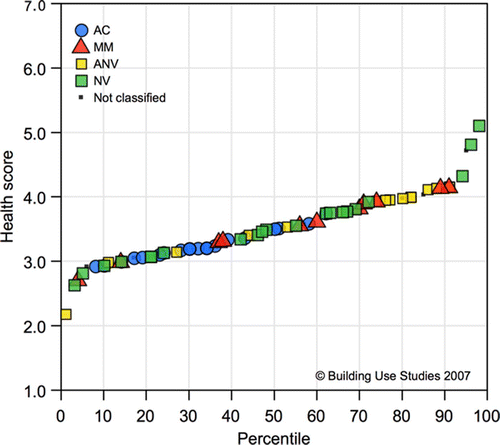
Features that people like
Users' likes are not always the reverse of what they complain about, although it can be safely said that the reverse of all the above apply. They also ask for the following.
| • | Workplaces near windows, with a view out Window seats are prized in offices, especially those with poorer environmental performance. They have also been a status symbol, occupied by those higher in rank. This can mean that the best spaces environmentally can be less frequently occupied as senior managers tend to be away from their desks more. However, recent trends have been for managers to have fewer private offices and for the offices that remain to be inboard. Deep-plan buildings can have as few as 40% of occupants who perceive their desks to be near a window.Footnote11 In shallow-plan offices this rises to 75–100%. | ||||
| • | Line-of-sight and earshot contact with immediate colleagues A basic requirement of workgroups is the ability to see and hear each other properly. Unwanted noise can be ‘tuned’ out where people can see as well as hear the things that are relevant to them. Unfortunately, green buildings often fail in this respect, either because they are too noisy, or because the space planning does not properly reflect design intent and people are asked to work in spaces which are not suitable (e.g. without windows or sliced up by circulation routes), or because of basic acoustic failings where people can hear others clearly at a distance but cannot hear close colleagues properly. | ||||
| • | Place for uninterrupted work For some work tasks such as software development, control over interruptions can be a primary requirement. Most people need quiet at some stage or other, but in predominantly open-plan floors it can be hard to obtain, so people work from home if they can. | ||||
| • | Good quality, controllable natural light Natural and artificial lighting systems are often poorly integrated, being designed solely to achieve specific illuminance levels and daylight factors, but not a pleasant, comfortably lit internal environment People are often at a loss to understand why more use is not made of natural light or, at least, why lights have to be left switched on unnecessarily. They are especially vociferous about this when they know that their building is supposed to have green credentials. As a recent case shows,Footnote12 even in the best disposed lighting environments, great care has to be taken to avoid occupants perceiving naturally lit spaces as ‘gloomy’ because this will almost invariably trigger unnecessary use of the lights. | ||||
How well do green buildings compare?
In theory, green buildings should perform well from the users' perspective because they will tend to have many of the features above. Using data from occupant surveys in 177 British buildings surveyed since 1995 using the Building Use Studies (BUS) occupant survey methodFootnote13 the present authors have compared results from conventional buildings with buildings with ‘green intent’ in their design briefs.Footnote14 Just because the design brief may have green goals and targets, this does not mean that these are fulfilled in practice. Therefore, not all the buildings included in the ‘green intent’ group are necessarily performing well.
and have results for the twelve ‘summary’ variables used in the BUS survey. Overall:
| • | The spread of scores is wider for the green-intent buildings, i.e. the best green buildings tend to be better than the best conventional, and vice versa, but a few lowest scoring are also green. | ||||
| • | As a group, green-intent buildings score better on summary variables for ventilation/air in summer and winter, comfort overall, design, health, image, lighting overall, perceived productivity and possibly temperature in winter. | ||||
| • | Differences in ratings for design and image variables are particularly noticeable, but this may partly be a result of the green buildings being newer. | ||||
| • | Green-intent buildings are about the same as the others for temperature in summer and noise overall. | ||||
Figure 3 Scores on principal user variables for conventional and green buildings. Building Use Studies UK data set 2007, n = 165. Box: 25th and 75th percentiles with median (50th percentile). Whisker: range of outliers. Scale 1 = unsatisfactory/uncomfortable; and 7 = satisfactory/comfortable.
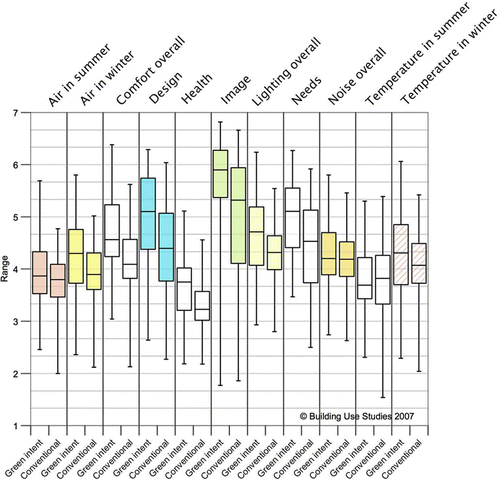
Figure 4 Scores on perceived productivity variable for conventional and green buildings. Building Use Studies UK data set 2007, n = 165. Box: 25th and 75th percentiles with median (50th percentile). Whisker: range of outliers

These results look encouraging. However, there is an important caveat. These are ratings based on ‘summary’ responses, e.g. they include any allowances that the occupants may make for context. When one starts to look at responses in more detail, the picture is somewhat less optimistic.
and have more detailed comparisons for temperature in summer and winter based on whether it is too hot or cold, or how much conditions vary. and are for ventilation/air in summer and winter (still, draughty, dry, humid, fresh, stuffy, smelly). has lighting (natural light, artificial light and glare); and noise (from colleagues, other people, other inside noise, noise outside and unwanted interruptions).Footnote15
Figure 5 Scores on temperature in summer variables for conventional and green buildings. Building Use Studies UK data set 2007, n = 165. Box: 25th and 75th percentiles with median (50th percentile). Whisker: range of outliers

Figure 6 Scores on temperature in winter variables for conventional and green buildings. Building Use Studies UK data set 2007, n = 165. Box: 25th and 75th percentiles with median (50th percentile). Whisker: range of outliers
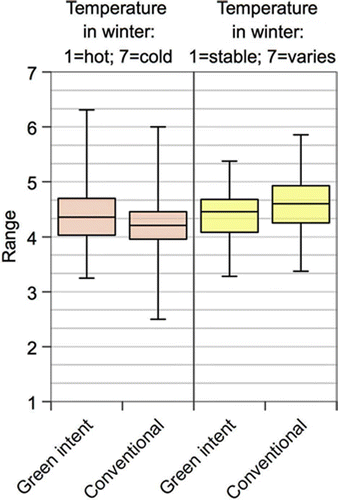
Figure 7 Scores on air/ventilation in summer variables for conventional and green buildings. Building Use Studies UK data set 2007, n = 165. Box: 25th and 75th percentiles with median (50th percentile). Whisker: range of outliers
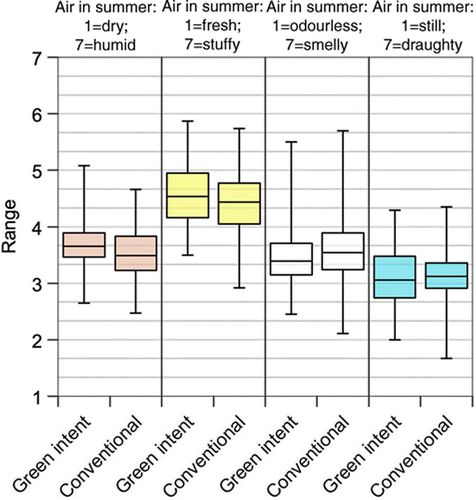
Figure 8 Scores on air/ventilation in winter variables for conventional and green buildings. Building Use Studies UK data set 2007, n = 165. Box: 25th and 75th percentiles with median (50th percentile). Whisker: range of outliers
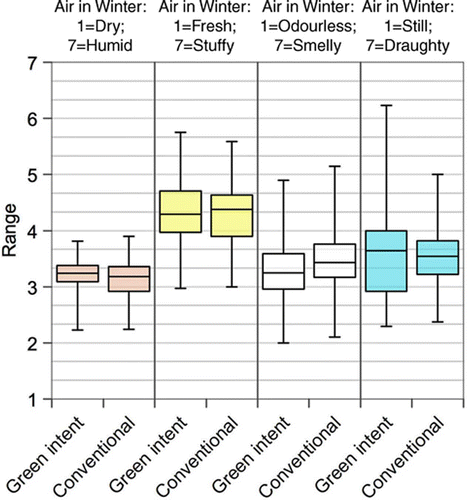
Figure 9 Scores on lighting variables for conventional and green buildings. Building Use Studies UK data set 2007, n = 165. Box: 25th and 75th percentiles with median (50th percentile). Whisker: range of outliers
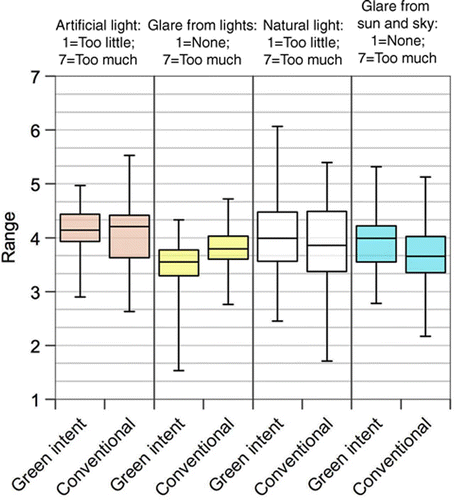
Figure 10 Scores on noise variables for conventional and green buildings. Building Use Studies UK data set 2007, n = 165. Box: 25th and 75th percentiles with median (50th percentile). Whisker: range of outliers
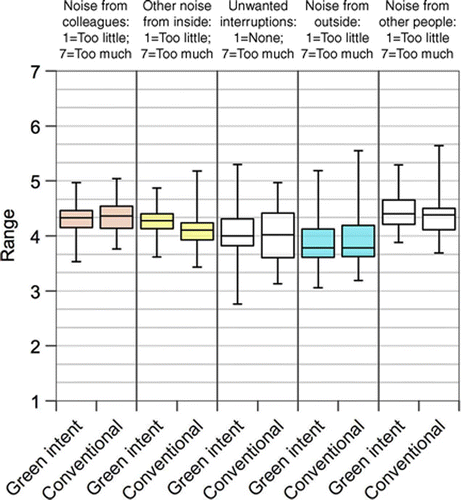
From :
| • | green buildings tend to be hotter in summer (); winter conditions are about the same () | ||||
| • | green buildings are perceived to be less dry, but more stuffy in summer () | ||||
| • | winter ventilation ratings are broadly similar () | ||||
| • | green buildings have less glare from the lights, but more glare from the sun and sky () | ||||
| • | green buildings tend to have more ambient noise, but otherwise noise conditions look similar | ||||
In other words, when some of the more detailed responses across the two groups are examined, differences are much less clear-cut.
As well as the Box and Whisker plots in , which show comparisons based on medians and inter-quartile ranges, more formal one-way analysis of variance tests are also included to highlight differences between means and variances in the green intent and conventional groups. In ten out of the 12 variables show that green-intent buildings are significantly different fromFootnote16 conventional, all of them better. However in only eight out of 21 have significant differences, and not all of these are in favour of the green-intent buildings (e.g. glare from sun and sky and noise from inside are better in conventional buildings).
The main reason why scores for summary variables differ from detailed variables is that they include context, a vital aspect and often neglected aspect of building performance studies.Footnote17
| • | As described above, occupants tend to be more ‘forgiving’ when features that they intrinsically like are present, as they tend to be in green buildings (e.g. views out, shallower plan forms, more control and better use of natural light and often more care taken in their briefing, design and management generally). | ||||
| • | Where design intent is made clearer to users, that is where users understand how the building is supposed to work, they are more likely to give the benefit of the doubt. This applies, for example, on a spectrum from where the users themselves may be designers, and have a more sophisticated understanding of how buildings function, to where the building is perceived as extremely usable and manageable because it has, for example, well-designed user controls. | ||||
| • | Where needs are met more quickly, and with less fuss, people tend to be more tolerant. This is another neglected are of building performance, and closely connected to the previous two points. | ||||
| • | If they like the design, and their experience of using the building is generally good and supportive of their work tasks, even if there are chronic problems with it, users will tend to be more tolerant. | ||||
Are users more tolerant of green buildings?
The tentative conclusion is that users are more tolerant of green buildings, but one must be extremely careful in interpreting the evidence. As has been shown:
| • | ratings scores for green buildings tend to be better than conventional buildings for more all-embracing, summary variables such as ‘comfort overall’ or ‘lighting overall’ | ||||
| • | when these are divided into their components, the favourable responses for green buildings are much less clear-cut | ||||
| • | users tend to rate design, image, needs and health as much better in green buildings, but these also may disguise many detailed flaws | ||||
| • | rating scores are relative: to get a fuller picture they should be put into a wider context by benchmarking individual cases within a bigger data set and by explaining individual circumstances as clearly as possible so that the reader can judge where importance and risk lies | ||||
On a broader front, the following are also found:
| • | green buildings are repeating past mistakes by creating unneeded and wasteful complexity, which can undermine their whole purpose; lessons are also only being learned slowly about the problems that can arise and the need for careful attention to detail | ||||
| • | green buildings are often more ‘fragile’ in their performance, so it is more important that everything works well together; for example, if the fabric is leaky, the control systems do not work well, or the fitting-out of the interior is unsympathetic with the design intent, then the consequences can be more serious than in a building that has power to spare | ||||
| • | unmanageable complexity is often downwind of features being added unnecessarily, and without regard to exigencies of, for example, running and maintenance costs | ||||
| • | smaller green buildings are often more successful than larger ones where it becomes much harder to resolve conflicting requirements of, for example, comfort, lighting, noise, the use of deep spaces and longer hours of operation | ||||
Notes
1Coined by H. A. Simon to describe consumer behaviour where people settle for less than optimal outcomes.
2For example, at Kingsmead School in Cheshire, UK, which rates very highly in user surveys, 21% of staff were dissatisfied with summer temperature conditions (Department for Education and Skills, Citation2006, pp. 12–19).
3Ventilation type classification: AC, mechanically conditioned including heating, cooling, and ventilation; windows not intended to be openable (though openable windows may sometimes be fitted for cleaning, emergencies or for future-proofing); NV, natural ventilation with openable windows but none automated; ANV, natural ventilation with some ventilation openings (not necessarily windows) automated and/or natural ventilation designed using airflow modelling aids and including mechanized (but not necessarily automated) unconventional elements; MM, almost everything else that combines natural and mechanical systems, but also see below. There is also an MV (mechanically ventilated) category available for heating and ventilation but no refrigeration cooling, but without windows that are normally opened. This is not common for office and educational buildings in the UK. Any would usually have windows that were also opened and so would be classed as MM. MM is subclassified as: concurrent (mechanical system operates during occupation, assisted by NV as necessary); changeover (mechanical system operates only when needed, e.g. for background winter ventilation, for summer night cooling, or when it is hot); and zoned (different parts of the building have different systems) (but see below). There is also a contingency MM category (where mechanical systems to be added or subtracted in the future). However, for the purposes of surveys of buildings in use, the systems would normally be classified in the state they happen to have been in the year or more before the survey. The rules apply to the majority (say 75%) of the representative parts of the usable area of the parts of the building being studied.
4Comfort overall is a variable based on occupants' ratings of perceived comfort taking into account the heating, cooling, ventilation, lighting and noise as a whole.
5‘Forgiveness’ is a derived variable based on dividing individual building mean scores for comfort overall by the average of temperature in summer, temperature in winter, ventilation/air in summer, ventilation/air in winter, lighting overall and noise overall. Values greater than 1 are taken to mean that occupants may be more tolerant, or ‘forgiving’, of the conditions.
6For examples of crises of discomfort in schools, see Haigh Citation(1982).
7There is also the question of absenteeism about which respondents are, unsurprisingly, rather reluctant to talk about. In a recent study of a relatively poor air-conditioned building, occupants were asked if the conditions in the building caused them to change their behaviour in any way. They stated they were more likely to take lunch breaks, have breaks away from their desks and computers, and go home at the normal time rather than work late. Some said they would work at home if they could. None said they went absent. In other words, poor conditions encouraged them to work more responsibly by following health and safety advice and not working longer hours! This is more like ‘escape behaviour’ than absenteeism.
8ASHRAE Citation(1998) has an introduction to adaptive comfort by M. Humphreys and F. Nicol plus ten technical papers on various aspects. See also De Dear and Brager Citation(1998).
9Humphreys and Nicol Citation(2000) showed that people were (on average) comfortable at about 20°C in 1978 (from data put together in 1978 but collected earlier) and at about 23°C in 1998 (from data put together by Gail Brager and Richard de Dear in Citation1998). The authors thank Fergus Nicol for help with this reference.
10No longer termed ‘sick building syndrome’ but now usually called ‘building-related health’.
11Extreme cases have no windows at all, which is obviously undesirable. These usually occur when space has been grabbed for emergency overflow accommodation, or where, for example, deep spaces such as libraries have been converted to office space.
12See Bunn Citation(2007), a case study of The National Trust Headquarters, The Heelis, Swindon, UK.
14The buildings used are those surveyed by Building Use Studies in the UK since 1997. This is not a random sample because a sampling frame has not been used. There is some evidence to show that this set of buildings may be better than the norm, but it is difficult to test this properly without a fully randomized design.
15The authors did not collect more detailed data in rating form for the variables' design, needs, image, health and perceived productivity. Qualitative feedback is used for these variables.
16Analysis of variance tests use p = 0.05 and 0.1 (i.e. 5 and 10% chances of the observed differences between green intent and conventional being wrong).
17One feature of the Probe post-occupancy studies was the lengths taken to explain individual circumstances in each of the case studies so that the reader was given sufficient detail to judge whether individual circumstances affected outcomes. Allowing for context is also becoming more important in other spheres. For example, in order to judge research findings it is often more telling to know who funds the research rather than what the findings actually say. ‘What's the context?’ is often the most important question that needs to be put in many kinds of discourse.
References
- ASHRAE . ASHRAE Winter Meeting . January 1998 . Field Studies of Thermal Comfort and Adaptation , San, CA, , US : ASHRAE . Technical Data Bulletin No. 14(1)
- Bordass , W. Flying blind: things you wanted to know about energy in commercial buildings but were afraid to ask . Paper presented at The Association for the Conservation of Energy and the Oxfordshire Energy Advice Centr . October 2001 . (available at: http://www.ukace.org/pubs/reports.htm)
- Bunn , R. March 2007 . “ Trust in construction ” . In BSRIA Delta T March , 10 – 13 .
- De Dear , R. and Brager , G. 1998 . Developing an adaptive model of thermal comfort and preference . ASHRAE Transactions , 104 ( 1a ) : 145 – 167 .
- Department for Education and Skills . 2006 . Design of Sustainable Schools: Case Studies , London : TSO . (available at: http://www.usablebuildings.co.uk)
- Leaman , A. , Thomas , L. and Vandenberg , M. 2007 . “ Green Buildings: What Australian Building Users are Saying ” . In Ecolibrium (originally prepared for http://www.yourbuilding.org), (forthcoming)
- Haigh , D. 1982 . “ User response in environmental control ” . In The Architecture of Energy , Edited by: Hawkes , D. and Owers , J. 45 – 63 . Harlow : Construction Press .
- Humphreys , M. A. and Nicol , J. F. 2000 . Outdoor temperature and indoor thermal comfort: raising the precision of the relationship for the 1998 ASHRAE database of field studies . ASHRAE Transactions , 106 ( 2 ) : 485 – 492 .
